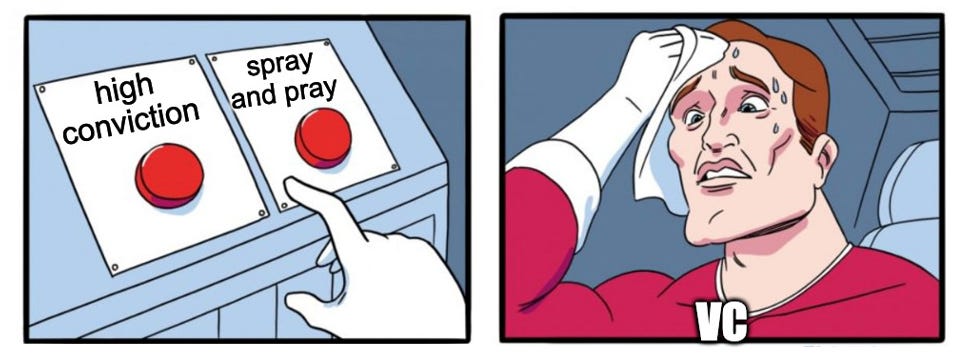📣 4min read to uncover the success rate of spray and pray.
Keep spreading the word and earn amazing benefits by referring your friends to this newsletter. Big thanks to Maxime Hurtebize for his support 🙏 See the support leaderboard here.
VC investment strategies can often be placed on a spectrum, from the meticulous due diligence of a sniper to the broad scope of "spray and pray".
1. What is 'Spray and Pray'?
In VC terms, "spray and pray" refers to making numerous smaller investments across a vast array of startups, hoping that one or a few will yield significant returns. It's a numbers game based on the belief that it's challenging to predict which startups will succeed.
2. Why Some Investors Swear by It:
Diversification: The broader the investment portfolio, the higher the chance that at least one startup will succeed and hit the Power Law. This can potentially offset losses from other ventures.
Emerging Markets: In nascent industries, particularly in climate tech hardware (where most of the impact occurs), predicting the next big breakthrough can be a challenge. A wider net might catch the next unicorn.
FOMO (Fear Of Missing Out): The rapid pace of technological innovation means potentially missing out on the next big thing. Spraying ensures more ground coverage.
3. The Stats: How Effective is It?
Historically, 65% of VC returns come from just 5% of investments. It indicates the high-risk, high-reward nature of VC.
Yet, spraying too thin may dilute the attention and support VCs can provide to each venture, possibly affecting potential winners adversely.
Contrary to popular belief, 90% of startups fail not because of bad ideas but because of poor execution, market fit, or other operational reasons. Thus, more meticulous vetting and involvement can potentially reduce this percentage.
4. The Case for a More Discerning Strategy:
Focused Expertise: By zeroing in on fewer startups, VCs can provide more significant mentorship, resources, and networking opportunities.
Quality over Quantity: A more discerning approach emphasizes understanding a startup's potential market, team, and technology, potentially leading to better ROI.
Building Sustainable Ventures: In climate tech, it's not just about quick returns. A focused strategy can ensure the birth and growth of companies that provide long-term environmental solutions.
5. Recommendations for Climate Tech Entrepreneurs and Investors:
Diversify, but Don't Dilute: While having a diversified portfolio is wise, make sure that each investment receives the attention it deserves.
Stay Contrarian: Climate tech is evolving. With the power of contrarian thinking, we can and will make significant progress in the coming decade.
Hit the TRL 5-7 Sweet Spot: Invest in technologies that have the greatest potential for impact and ROI and are at Technology Readiness Level (TRL) 5-7.
Conclusion
While the "spray and pray" strategy might be enticing given the unpredictable nature of VC returns, it’s not the silver bullet for all investors. A broad diversification strategy can be well-suited for super early stages, such as pre-seed and early seed, but combining breadth with depth is key to unlocking success in later stages, such as Series A and beyond.
Whenever you're ready, there are 2 ways I can help you:
Invest In Climate Tech Like A VC 🎓: Join over 200 students in my cohort-based course to learn how to find unique Climate Tech startups that will change the world, and how to start investing in them regardless of your budget.
Join my Climate investor community 🚀 Unlock access to groundbreaking climate deals. Dive into transformative deals like our recent nuclear fusion venture and two pioneering moonshot projects.
If you are enjoying this newsletter, the best support would be to recommend it to a Climate friend or colleague 🙏





